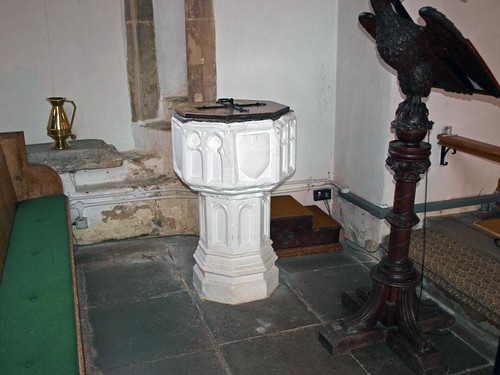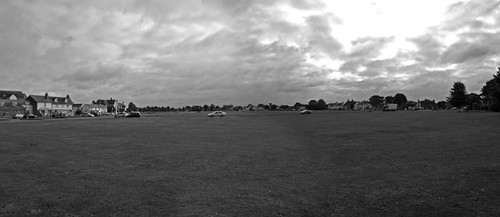St Mary the Virgin is one of the interesting churches but only to a limited extent - Norman lancets and North door (which is quite poor). Inside it's been thoroughly restored and contains little of interest other than the chancel niches.
What really catches the eye here though is the village green which is more a green with a village attached - why it is so large (43 acres) I have no idea but suspect that it somehow avoided enclosure.
ST MARY THE VIRGIN. Nave, chancel, and W tower. The N side shows clearly that nave and chancel are Norman. The puddingstone is laid diagonally and bedded in excessive amounts of mortar. N doorway with responds with a scroll each. Arch extrados with trellis decoration. S doorway with one order of slightly decorated scalloped capitals, gabled lintel with two tiers of rosettes and voussoirs with zigzag. The E end of the chancel is C19, but has two charming early C14 niches inside with rosettes in the jambs, ogee tops, and leaf sprigs in the spandrels. W tower later C14, with diagonal buttresses, W doorway with fleurons, three-light W window, later battlements. - FONT. Octagonal, with trefoils and shields; simple. - TILES. Nine tiles of c. 1300 in front of the altar; red, with pattern including a stag and a greyhound. - MONUMENT. P. Thompson d. 1865, by Sanders of Euston Road, still in the traditions of 1800.
GREEN. The village green of Great Bentley is the largest in Essex, so large that it is almost a common. Whatever houses border on it seem small, seen across the green, and there are in any case hardly any larger than cottages. One tongue reaches into the green, and two islands are in it, one with a white Early Victorian villa and the dark trees of its garden, the other with the red brick. METHODIST CHAPEL of 1843 (with Gothic windows) and other later red brick buildings. The best houses are on the SW side, towards the church.
GREAT BENTLEY. Here is a village green of 42 acres, with roads crossing it and ducks and chickens popping out from gates of cottages as they have done since Norman children played their games on this great place.
There is a pond by the green with 17th century houses behind it, and round the corner is the big churchyard. Passing through its gate we make our way under an avenue of lopped poplars to a timbered porch of the 14th century, with a carved Norman doorway inside.
We may see here too how deftly the Normans used their axes in carving the chevrons, the sunflowers, and the other rich ornaments of the doorway which also has two medieval sundials on the other side. To right and left above this door are the narrow round windows of the same age. The chancel was lengthened and the solid tower added 600 years ago. It was only in our own time that the roof of the chancel and the nave were revealed, and both are splendid examples of timber work of five hundred years ago.
The village has a pathetic memory of the bitter days of Mary Tudor’s reign. There lived here a family of three, William Munt, his wife Alice, and their daughter Rose, who belonged to a little group of people who used to gather together to read the Bible. There was a Judas among them, a priest named Thomas Tye, who left the group and reported its practices to Bishop Bonner. The agents of the torturers met Rose Munt and tried to shake her faith by putting her hand in a candle flame, but Rose declared that if she were compelled to burn she would be given the strength to bear it. William and his wife were over 60, but Rose was 20, yet when the three were thrown into prison she went there singing. In their death this little family was not divided, for all three were burnt together in Colchester.
There is a pond by the green with 17th century houses behind it, and round the corner is the big churchyard. Passing through its gate we make our way under an avenue of lopped poplars to a timbered porch of the 14th century, with a carved Norman doorway inside.
We may see here too how deftly the Normans used their axes in carving the chevrons, the sunflowers, and the other rich ornaments of the doorway which also has two medieval sundials on the other side. To right and left above this door are the narrow round windows of the same age. The chancel was lengthened and the solid tower added 600 years ago. It was only in our own time that the roof of the chancel and the nave were revealed, and both are splendid examples of timber work of five hundred years ago.
The village has a pathetic memory of the bitter days of Mary Tudor’s reign. There lived here a family of three, William Munt, his wife Alice, and their daughter Rose, who belonged to a little group of people who used to gather together to read the Bible. There was a Judas among them, a priest named Thomas Tye, who left the group and reported its practices to Bishop Bonner. The agents of the torturers met Rose Munt and tried to shake her faith by putting her hand in a candle flame, but Rose declared that if she were compelled to burn she would be given the strength to bear it. William and his wife were over 60, but Rose was 20, yet when the three were thrown into prison she went there singing. In their death this little family was not divided, for all three were burnt together in Colchester.



No comments:
Post a Comment